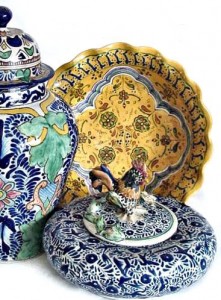 When we speak about Puebla we inevitably think about the imposing volcanoes that guard her, the Popocateptl and Iztaccíhuatl , the culinary delicacies that were created in this state, such as Mole Poblano, its baroque architecture, and of course, the ceramic of Talavera, that adorns practically every building, every patio, every square and even kitchens.
When we speak about Puebla we inevitably think about the imposing volcanoes that guard her, the Popocateptl and Iztaccíhuatl , the culinary delicacies that were created in this state, such as Mole Poblano, its baroque architecture, and of course, the ceramic of Talavera, that adorns practically every building, every patio, every square and even kitchens.
Talavera is a type of majolica earthenware, a white and glazed type of ceramic. Although the Spaniards introduced this type of pottery, ironically the term Talaverais used much more in Mexico than in Talavera de la Reina, Spain.
In fact, Talavera is the oldest tin-glazed ceramic in America and it is still being manufactured with the same techniques as in the 16th Century.
Puebla not only was the second most important city in Mexico, after the country’s capital Mexico City, it was the most important earthenware center of the Nueva España, which was the name of Mexico in Colonial times.
The production of tiles and ceramic ware in Puebla, started almost immediately the city was established in 1531. Thanks to the abundance of quality clay in the region and to the splendor of the arts at that time in Puebla, in a short time the Talavera Poblana achieved such quality and beauty that it was soon exported to the rest of the continent.
There are several theories about its origin in Mexico, but the most accepted explanation is that Spanish monks from the Santo Domingo monastery in Puebla, sent for craftsmen from Talavera de la Reina to teach the indigenous people of the region how to work the clay so they could create pieces similar to the ones produced in Spain. They wanted to decorate with tiles and religious sculptures their monastery and church.
Other versions state that the Dominican friars were the ones that knew how to produce this type of ceramic and that they were the ones that taught the Indians how to do it.
The truth is there are documents that record the presence of several craftsmen from Talavera de la Reina in Puebla during the 16th Century, which established their workshops to produce tiles and ceramic wares. It was a very profitable business since there were so many churches and monasteries being built.
In time, a potter’s gild was formed and Ordinances were laid down, that all of the potters that wished to produce Talavera had to follow. This was done so that the quality of the ceramics called Talavera was uniform and that this earthenware had a distinctive style and excellence.
Some of the rules established by the Ordinances were:
-
The color blue was to be used on the finest ceramic. This was so because the mineral pigments needed to produce this color were very expensive. The customer could then easily distinguish the quality of fine ceramic from one of lesser quality.
-
To avoid falsifications each master potter had to sign or mark his products.
